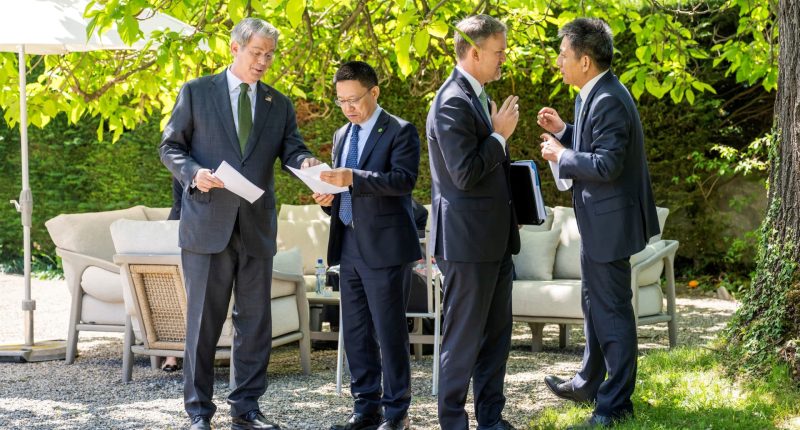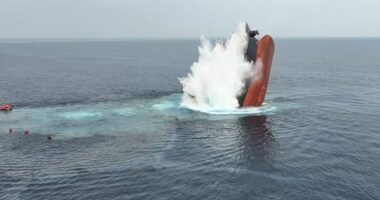Share this @internewscast.com
U.S. Secretary of the Treasury Scott Bessent, China’s Vice Minister of Finance Liao Min, U.S. Trade Representative Jamieson Greer, and China’s International Trade Representative and Vice Minister of Commerce Li Chenggang, meet on the day of a bilateral meeting between the U.S. and China, in Geneva, Switzerland, May 11, 2025.
Keystone/eda/martial Trezzini | Via Reuters
Chinese trade envoy Li Chenggang described talks with the U.S. as “good” after their first high-level engagement in Switzerland on May 12 led to a thawing in trade tensions. However, both sides have continued to trade thinly veiled swipes.
When asked by CNBC whether the dialogues were constructive, Li, who met U.S. Trade Representative Jamieson Greer on the sidelines of the Asia-Pacific Economic Cooperation Trade Ministerial meeting in Jeju on Thursday, answered, “definitely,” without giving further details or clues on forthcoming meetings between the two sides.
Li told reporters that he had no information on whether there would be a meeting or a call between U.S. President Donald Trump and his Chinese counterpart Xi Jinping.
On the same day, He Yongqian, spokesperson for China’s Ministry of Commerce, struck a similar restrained tone, offering no new details on the trade talks during a daily press briefing that began an hour later than usual.
Trump had touted earlier this week that he might speak to Xi at the end of this week, while Beijing appeared tight-lipped on that prospect. Analysts expect direct engagement between the two leaders would likely indicate more meaningful progress in talks.
The first round of negotiations in Geneva was cheered in Beijing as vindication for China’s uncompromising response to Trump’s tariffs.
Both sides agreed to temporarily lower duties to allow more time to negotiate a more permanent deal while putting in place a “communication mechanism” on economic and trade issues.
The tariff reprieve also somewhat brightened China’s economic outlook, prompting some economists to raise this year’s growth forecast.
The potshots continue
Despite the tariff truce, both sides have continued to take swipes at each other in other areas, underscoring the fragility of the strained ties.
The U.S. Commerce Department’s Bureau of Industry and Security Tuesday warned companies not to use Huawei’s Ascent AI chips, drawing criticism from Beijing, calling it an act of “abusing export control measures.”
China’s foreign ministry on Friday toughened its tone a notch, decrying the U.S.’s “long-arm jurisdiction,” saying China will “never accept it.”
Meanwhile, China is keeping a firm grip on its export controls on critical minerals. Rare earth minerals, which are crucial to the U.S. industry, are viewed by Beijing as an effective leverage in its trade negotiations with the Trump administration.

China’s Commerce Ministry, in a statement earlier this week, urged local authorities to clamp down on the smuggling of rare earths.
China started blocking exports of several rare earth metals on April 4 in retaliation for Donald Trump’s “liberation day” tariffs.
Companies that want to export these items need to obtain approval from China’s commerce ministry. At least four rare earth magnet producers have obtained such export permits, including suppliers to German automaker Volkswagen, Reuters reported.
When asked about the rare earth controls during the regular press conference Thursday, China’s Ministry of Commerce spokesperson said it did not have any information to provide.
Rare earth misread
Beijing could be overestimating the importance of rare earth minerals to the Trump administration, said Dennis Wilder, a former senior White House intelligence official. Wilder currently serves as a senior fellow for the Initiative for U.S.-China Dialogue on Global Issues at Georgetown University.
“If China overplays this card, the United States will find other ways to get rare earths,” he said, naming Canada as an alternative source.
He added that Chinese leadership also underestimated the need to pledge more forceful measures to crack down on the fentanyl flows.
Separately, Nicholas Burns, America’s former ambassador to Beijing, said on Wednesday that “there is going to be a price to pay” if China fails to cooperate on the fentanyl issue.
The upcoming negotiations are “high-stake” for Beijing as China “has more to lose” if the tariff suspension expires, Neo Wang, lead China economist and strategist at Evercore ISI, said in a note on Monday.
Wang said he expects Beijing would seek to “please Trump in a way that benefits the Republican party in the midterm election” next year. These include promises to ramp up purchases of U.S. goods or increase its investment in the U.S.
If Chinese officials determine that a broader trade deal is unlikely, they may instead prioritize resolving the 20% levies linked to fentanyl by making concessions on fentanyl enforcement and TikTok’s sales in the U.S., which Wang described as Trump’s “real target.”
— CNBC’s Evelyn Cheng contributed to this story.










